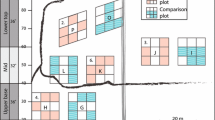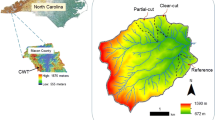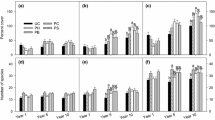Abstract
In this article, we report on the increments in basal area and tree diameter as well as the structural development observed in variously thinned plots that underwent either uneven- or even-sized treatment. The experimental forest was originally an uneven-sized mixed stand dominated by Picea abies. Twenty-eight randomized sample plots underwent each treatment, and the trees were monitored for 15 growing seasons after thinning. The uneven-sized plots retained a reverse J-shaped diameter distribution, but this was changed into a bell shape by low thinning in the even-sized plots. Absolute basal area increment was positively correlated with basal area in the even-sized treatment but not in the uneven-sized treatment. In the latter, all of the plots grew almost equally well, and only the basal area of broadleaves explained slightly positively the increment variation. Relative basal area increment was negatively correlated with basal area in both treatments. Additionally, the basal area of Scots pine was a positive explanatory variable in the relative increment variation in the even-sized treatment. For the dominant Norway spruce trees, diameter increment was negatively correlated with basal area in both treatments and, conversely, heavy removal increased the diameter increment. Relative basal area increment averaged 5% annually in uneven-sized plots representing the “target selection.” This was more than double the increment observed for the even-sized plots that represented the “prevailing practice.” Likewise, the diameter increment of Norway spruce trees was 48% greater in the uneven-sized compared to the even-sized plots.




Similar content being viewed by others
References
Agestam E (1985) En produktionsmodell för blandbestånd av tall, gran och björk i Sverige (Report No. 15, in Swedish). Department of Forest Yield Research, Swedish University of Agricultural Sciences, Uppsala
Andreassen K (1994a) Bledning og bledningsskogen—en litteraturstudie (in Norwegian). Aktuelt fra Skogforsk 2:23
Andreassen K (1994b) Development and yield in selection forests. Meddelelser fra Skogsforsk 47:1–37
Assmann E (1970) The principles of forest yield study. Pergamon, New York, p 506
Biolley H (1887) Quelqes réflexion sur le jardinage à propos des publications de M. Gurnaud (in French). Schweizerische Forstwesen 38:189–192
Cajander AK (1949) Forest types and their significance. Acta For Fenn 56:1–71
Chrimes D (2004) Stand development and regeneration dynamics of managed uneven-aged Picea abies forests in Boreal Sweden (Ph.D. thesis). Department of Silviculture, Swedish University of Agricultural Sciences, Umeå, p 25
Goff FG, West D (1975) Canopy–understory interaction effect on forest population structure. For Sci 21:98–108
Hanewinkel M (2001) Financial results of selection forest enterprises with high proportions of valuable timber: results of an empirical study and their application. Schweitzerische Zeitschrift für Forstwesen 152:343–349
Hellström E (2001) Conflict cultures—qualitative comparative analysis of environmental conflicts in forestry. Silva Fennica Monogr 2:109
Hyytiäinen K, Tahvonen O, Valsta L (2005) Optimum juvenile density, harvesting, and stand structure in even-aged pine stands. For Sci 51:120–133
Jonsson B (1962) Om barrblandskogens volymproduktion (Yield of mixed coniferous forest) (in Swedish, with English summary). Meddelande från Statens Skogsforskningsinstitut 50:1–143
Kenk G (1995) Growth and yield in even-aged and uneven-aged silvicultural systems in the conifer-dominated forests of Europe. In: Bamsay CR (ed) Proceedings of Innovative Silviculture Systems in Boreal Forests (IUFRO Symposium in Edmonton, Alberta, Canada, 2–8 October 1994). Natural Resources Canada, Canadian Forest Service, Ottawa, pp 26–32
Lähde E, Laiho O, Norokorpi Y, Saksa T (1991) The structure of advanced virgin forests in Finland. Scand J For Res 6:527–537
Lähde E, Laiho O, Norokorpi Y, Saksa T (1992) Alternative silvicultural treatments as applied to advanced stands—research plan. In: Hagner M (ed) Silvicultural alternatives (proceedings from an internordic workshop, June 22–25 1992) (Report No. 35). Department of Silviculture, Swedish University of Agricultural Sciences, Uppsala, pp 66–73
Lähde E, Laiho O, Norokorpi Y, Saksa T (1994) Structure and yield of all-sized and even-sized conifer-dominated stands on fertile sites. Ann Sci For 51:97–109
Lähde E, Laiho O, Norokorpi Y (1999) Diversity-oriented silviculture in the boreal zone of Europe. For Ecol Manage 118:223–243
Lähde E, Laiho O, Norokorpi Y, Saksa T (2002) Development of Norway spruce-dominated stands after single-tree selection and low thinning. Can J For Res 32:1577–1584
Lundqvist L (1993) Changes in the stand structure on permanent Picea abies plots managed with single-tree selection. Scand J For Res 8:510–517
Nilson K (2001) Regeneration dynamics in uneven-aged Norway spruce forests with special emphasis on single-tree selection (Ph.D. thesis). Department of Silviculture, Swedish University of Agricultural Sciences, Uppsala, p 24
Nilsson N-E, Östlin E (1961) Riksskogstaxeringen 1938–1952 (in Swedish) Statens skogsforskninginstitut. Avdelningen för Skogstaxering Rapporter 2:162
O’Hara KL (1996) Dynamics and stocking-level relationships in multi-aged ponderosa pine stands. For Sci 42(Monograph 33):1–34
O`Hara KL (1998) Silviculture for structural diversity. A new look at multiaged systems. J For 96:4–10
Pukkala T, Vettenranta J, Kolström T, Miina J (1994) Productivity of mixed stands of Pinus sylvestris and Picea abies. Scand J For Res 9:143–153
Pukkala T, Lähde E, Laiho O (2009) Growth and yield models for uneven-sized forest stands in Finland. For Ecol Manage 258:207–216
Rouvinen S, Kuuluvainen T (2005) Tree diameter distributions in natural and managed old Pinus sylvestris-dominated forests. For Ecol Manage 208:45–61
Schuberg K (1886) Schlaglichter zur Streitfrage: Schlagweiser Hochwald-oder Femelbetrieb (in German). Forstwissenschaftliches Centralblatt 8:129–148, 193–226
Schütz J-Ph (1989) Der Plenterbetrieb (in German). Fachbereich Waldbau, Zürich, p 54
Schütz J-Ph (1999) The Swiss experience: more than one hundred years of experience with a single-tree selection management-system in mountainous mixed forests of spruce, fir and beech. In: Emmingham WH (ed) Proc IUFRO Interdisciplinary Uneven-Aged Management Symp, Corvallis, OR, 15–19 Sept 1997, pp 21–24
Siiskonen H (2007) The conflict between traditional and scientific forest management in 20th century Finland. For Ecol Manage 249:125–133
Tahvonen O (2009) Optimal choice between even- and uneven-aged forestry. Nat Resour Model 22:289–321
Weetman GF (1995) Silviculture systems in Canada’s boreal forest. In: Bamsay CR (ed) Innovative silviculture systems in boreal forests (Proceedings of IUFRO Symposium in Edmonton, Alberta, Canada, 2–8 October 1994). Natural Resources Canada, Canadian Forest Service Canada, Ottawa, pp 5–16
Zackrisson O, Nilsson M-C, Steijlen I, Hörnberg G (1995) Regeneration pulses and climatic-vegetation interactions in non-pyrogenic boreal Scots pine stands. J Ecol 83:1–15
Zürchner V (1965) Die Idee der Nachhaltigkeit unter spezieller Berücksichtigung der Gesichtpunkte der Forstreinrichtung (in German). Mitteilungen der Schweizerische Anstalt für des forstliche Versuchswesen 41:91–218
Author information
Authors and Affiliations
Corresponding author
About this article
Cite this article
Lähde, E., Laiho, O. & Lin, C.J. Silvicultural alternatives in an uneven-sized forest dominated by Picea abies . J For Res 15, 14–20 (2010). https://doi.org/10.1007/s10310-009-0154-4
Received:
Accepted:
Published:
Issue Date:
DOI: https://doi.org/10.1007/s10310-009-0154-4




